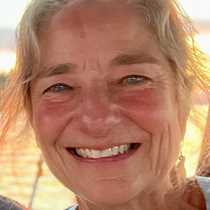Prince of Wales Reach, Malibu Rapids, & Princess Louisa Inlet
Early risers were rewarded with a beautiful sunrise off the bow as we traveled east, and then turned north into Prince of Wales Reach. Glaciers had carved steep-sided scenery and a spectacular fjord here on the British Columbia mainland. As we made our way deeper into the fjord, the scenery grew more spectacular: mountains reached up more than 4,000 feet, and the seafloor dropped more than 2,000 feet.
The green hills and mountains were covered by forests of western redcedar and Douglas fir. We passed by many clear cut areas zigzagged by logging roads which ended at water’s edge. The steepest cut hillsides lacked roads where helicopters had lifted out logs. All around us the landscape was a patchwork of different shades of green – trees of different ages – and sheer rock cliffs.
Berit gave a presentation on marine mammals in mid-morning. We investigated petroglyphs on the fjord’s wall, and enjoyed a barbecue lunch on the sun deck under warm, partly sunny skies. The timing of our entrance into Princess Louisa Inlet is critical; currents in the narrows can be 14 knots! A Zodiac sent to scout conditions at the inlet’s entrance reported no current. The National Geographic Sea Lion zigged, then zagged past an islet, and through the tiny passage called Malibu Rapids. People on shore waved, and we returned the friendly gesture. Meanwhile, the water depth rose to just 35 feet – plenty for our safe passage, but a dramatic change from the 440 foot depth nearby!
Mountaintops here took on shapes of shark teeth, and rounded, thin triangles. All visible surfaces had been smoothed by ice eons ago, but somewhere hidden in the clouds was a jagged, towering 8,000 foot peak. Thin waterfalls streamed down cliffs, and salt water nearly touched tree limbs overhanging the fjord.
Ashore, we hiked a short distance through rich, green, moss-covered forest of redcedar and ferns to the base of Chatterbox Falls. Some branches were covered all around in thick moss and ferns, while others were draped in strings of delicate yellow-green mosses and long, gray-green lichens. The forest was lush . . . and ALIVE! The wide, white waterfall created mists which covered fallen trees and logs at the foot of the falls.
We investigated the magical surroundings by kayak and Zodiac. The light mist and drizzle rewarded us generously - a rainbow!
Before dinner, Chuck, a fellow traveler and talented folksinger, sang some hearty, traditional sailing songs featuring the Vancouver area. Many thanks to you, Chuck, and to all who have shared this exploration of Puget Sound and British Columbia.
Early risers were rewarded with a beautiful sunrise off the bow as we traveled east, and then turned north into Prince of Wales Reach. Glaciers had carved steep-sided scenery and a spectacular fjord here on the British Columbia mainland. As we made our way deeper into the fjord, the scenery grew more spectacular: mountains reached up more than 4,000 feet, and the seafloor dropped more than 2,000 feet.
The green hills and mountains were covered by forests of western redcedar and Douglas fir. We passed by many clear cut areas zigzagged by logging roads which ended at water’s edge. The steepest cut hillsides lacked roads where helicopters had lifted out logs. All around us the landscape was a patchwork of different shades of green – trees of different ages – and sheer rock cliffs.
Berit gave a presentation on marine mammals in mid-morning. We investigated petroglyphs on the fjord’s wall, and enjoyed a barbecue lunch on the sun deck under warm, partly sunny skies. The timing of our entrance into Princess Louisa Inlet is critical; currents in the narrows can be 14 knots! A Zodiac sent to scout conditions at the inlet’s entrance reported no current. The National Geographic Sea Lion zigged, then zagged past an islet, and through the tiny passage called Malibu Rapids. People on shore waved, and we returned the friendly gesture. Meanwhile, the water depth rose to just 35 feet – plenty for our safe passage, but a dramatic change from the 440 foot depth nearby!
Mountaintops here took on shapes of shark teeth, and rounded, thin triangles. All visible surfaces had been smoothed by ice eons ago, but somewhere hidden in the clouds was a jagged, towering 8,000 foot peak. Thin waterfalls streamed down cliffs, and salt water nearly touched tree limbs overhanging the fjord.
Ashore, we hiked a short distance through rich, green, moss-covered forest of redcedar and ferns to the base of Chatterbox Falls. Some branches were covered all around in thick moss and ferns, while others were draped in strings of delicate yellow-green mosses and long, gray-green lichens. The forest was lush . . . and ALIVE! The wide, white waterfall created mists which covered fallen trees and logs at the foot of the falls.
We investigated the magical surroundings by kayak and Zodiac. The light mist and drizzle rewarded us generously - a rainbow!
Before dinner, Chuck, a fellow traveler and talented folksinger, sang some hearty, traditional sailing songs featuring the Vancouver area. Many thanks to you, Chuck, and to all who have shared this exploration of Puget Sound and British Columbia.




